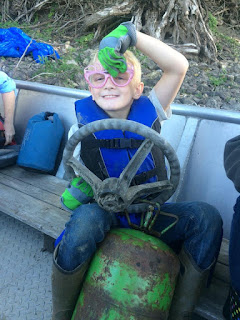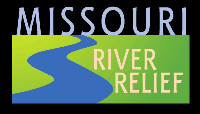In the summer of 2017, Missouri River Relief was blessed to have Leif Nordstrom join the ranks as full-time seasonal education assistant intern. At the end of his positions, we asked Leif to share a few “words of wisdom” to the next education assistant.
 |
| The Missouri River Academy, one of MRR's major events of the year |
To the Next Education Assistant Intern,
SPLASH! Wake up! You’ve fallen into the Missouri River with no life jacket, no boat, no help, and it’s up to you to make it back to shore. This scenario might be analogous to the feelings you experience during your first day as the Missouri River Relief (MRR; get used to that acronym, it’s going to come up ALOT over the course of the next few months). This is completely normal, so take a breath, and remember where you’ve been, where you are, and where you’re going.
For me, working as the MRR education assistant was the first ‘office job’ I had ever had, as I spent my years as an undergraduate working in the food industry. Admittedly, I was very nervous on my first day. What helped me the most was reflecting on these thoughts: where I’ve been, where I am, and where I’m going. As I’ve discovered in life, self-awareness is critical to success, so acknowledging my past experiences as well as my ambitions for the future helped me by bringing my unique collection of skill-sets and experiences to the forefront. Then I took a breath, settled into my new office job, and put those skills to work.
I would like to present the next education assistant with a challenge: over the next few months, you will spend each day working on something different. Now, you can view this challenge in two ways: an inconsistent annoyance, or a unique opportunity for growth. While you won’t be doing something entirely different each day, this challenge represents an ideology that will be helpful to ascribe to, both at MRR and in life. View each day as a new opportunity. As you’ll find in the Words of Wisdom bullet points below, I ask you to always be moving, both mentally and physically. This is a method that I picked up while in the food business, but can easily be translated to work in an office, and resonates with this ‘new day’ ideology.
To begin each day, look over your projects list and identify what you think is the most pressing. This will change regularly, as your work is going to be built around upcoming events, with a few long-term projects peppered in-between. For example, if there is a multiple-day education event happening within the next two weeks, you will likely be working on preparing paperwork, gathering materials, or writing a press release. After you’ve picked a project, dive right into it. The reason the Education Coordinator chose you as the intern is because of your talents, and one of the greatest benefits of the job is the freedom you are afforded to utilize your unique skills to create, so don’t neglect your intuition when working on projects. That being said, you should keep an open mind, as a more complete work will be found through collaboration with the Education Coordinator and other MRR staff, which means incorporating outside ideas and editing.
While the goal of the projects list is to establish your independence – in other words, so that you don’t have to bother the Education Coordinator every second asking for things to do – I like to check in with the Education Coordinator a few times a week, and at least ask them what they are working on for the day. This is an informal way to get familiar with the type of work the Education Coordinator does, but also an opportunity to get to know them better. I recommend you see this job in two ways: an opportunity to learn professional skills in a unique setting, but also the chance to meet some really friendly people. Take time to get to know both the Education Coordinator and the other MRR staff; they want to get to know you.
 |
| The Educator Workshop, another one of MRR's major events of the year. |
As the Education Assistant, your primary focus is MRR education. This includes two major events: the Educator Workshop and the behemoth, also known as the Missouri River Academy. Both events will require a great amount of preparation, and you will help the Education Coordinator to carry out these events, assisting in various ways, such as taking pictures, setting up for meals, serving as a deck-hand, and more. Much, much more. The greatest advice I can give regarding these events is to stay calm, and always be present. You won’t always be in the forefront and in fact, you will spend most of the time in the background. But always be doing something, and keep an eye out for any way that you can make Kristen’s job easier.
In addition, keep notes on what can be improved and what you think has gone especially well. This internship is a two-way street: you are helping MRR, but they are also helping you. The Education Coordinator sees this internship as a great opportunity to teach and help you grow as a professional so the Education Coordinator will be challenging you, and asking for your thoughts and recommendations.
Now let’s get down to the brass tacks, there are a few things that I learned along the way as well.
- The meaning of ‘Schlepping’. – The physical action of moving items up, down, and around from one place to another. Usually involves stairs, sweat, and multiple trips. When schlepping, keep in mind that after you have schlepped items to one place, you will eventually have to schlepp them back.
- When traveling to an MRR event where you will be camping, ensure that you are adequately prepared. This includes - but is not limited to - a raincoat, boots, sleeping bag, sleeping pad, extra shoes/socks, and a tent.
- Take 15 minutes to talk with MRR Staff about tying knots. Practice these… they will prove VERY useful as a deckhand.
- Be prepared to serve as the MRR ‘head of culinary operations’. Duties include chopping watermelon, slicing Hawaiian Sweet Rolls, and schlepping coolers of food. As head of culinary operations, it is imperative that when picking up a HyVee online order, always remember to check that ALL ITEMS are included.
- At times, you will be required to drive an MRR vehicle and tow an MRR boat. When doing so, remember that your turns should always be wide.
- When ordering food for 123 people, do not hesitate to greatly exaggerate the serving size presented on the container.
- When posting on the River Notes blog, make sure that you have ‘filtered’ your text through a simple processor (notepad) and always upload photos using the Blogger website. NEVER copy and paste pictures into Blogger.
- When possible, use resources you can already find in the office. The office bookshelf or the Education Coordinators book collection can provide some great information.
- When using files from MRR file sharing service, make sure that others are not currently making changes to that document. This will create a duplicate file and can be very confusing.
- When packing shirts for the Academy, check that the sizes are not youth sizes (unless you want them to be).
- Before, during, and after an event, always make sure that the MRR camera is loaded with batteries, including at least one set of back-ups.
View this job as a challenge to show that you can swim, even with no life jacket, boat, or help; give it your all, and I assure you that you will make it to shore with a sense of great accomplishment and satisfaction.
So, with that, I wish you good luck, and I’ll see you on the river!
Sincerely,
Leif Nordstrom
2017 Education Assistant Intern
To learn more about Missouri River Relief's internship program, visit www.riverrelief.org
To learn more about Missouri River Relief's internship program, visit www.riverrelief.org





































